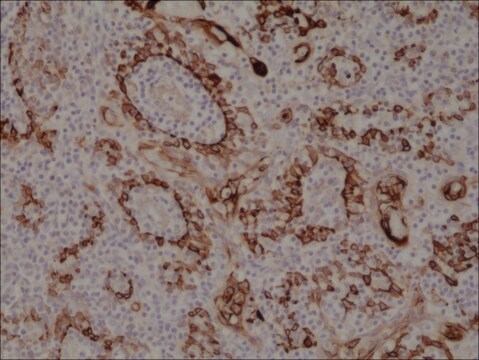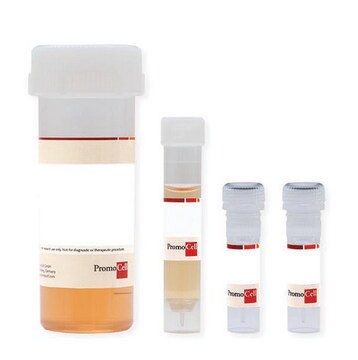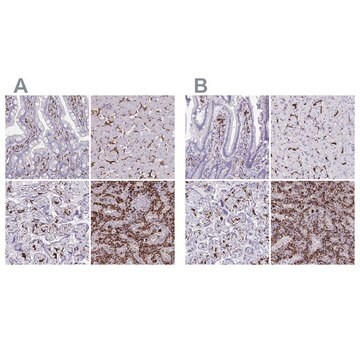CAR-217
Cardiolipin Liposomes
PC:CL (0.5:99.5 molar ratio 10mM)
Sign Into View Organizational & Contract Pricing
All Photos(1)
About This Item
UNSPSC Code:
12352211
Recommended Products
Quality Level
composition
Phosphate buffered saline
concentration
10 mM
impurities
0.5 mol % L-alpha-phosphatidylcholine (PC)
99.5 mol % Cardiolipin (CL)
particle size
100 nm
pH
7.4
Looking for similar products? Visit Product Comparison Guide
General description
Liposomes are extensively used to study the interaction of proteins, peptides and other molecules with the surface of a lipid membrane.
Cardiolipin (CL) is a unique phospholipid with an interesting chemical and ultrastructural characteristics. It is a highly acidic dimer of phosphatidylglycerol (PG) and phosphatidic acid (PA) containing four acyl chains, three glycerols and two phosphate headgroups. Due to deprotonation of one of these phosphate groups, cardiolipin is negatively charged in physiological pH.
Cardiolipin (CL) is known as a mitochondria-specific phospholipid and is intimately linked to mitochondrial bioenergetic processes. It plays a functional role in mitochondrial membrane stability and dynamics, as it interacts with a number of inner mitochondrial membrane metabolite carriers, enzymes and proteins. Extensive studies of phamacological, toxicological, and therapeutic effects have shown that the incorporation of doxorubicin in cardiolipin liposomes improved antitumor activity. It has been reported that cardiolipin-containing liposomes have lower cardiotoxicity associated with doxorubicin by alteriing the pharmacokinetics and tissue distribution of the drug.
Cardiolipin is a negatively charged lipid and provides two types of binding possibilities: binding at the surface and encapsulation deep within the membrane. Our catalog of cardiolipin lipids contains many different types of saturated and unsaturated cardiolipin based liposomes made from 0.5% up to 100% cardiolipin.
Cardiolipin (CL) is a unique phospholipid with an interesting chemical and ultrastructural characteristics. It is a highly acidic dimer of phosphatidylglycerol (PG) and phosphatidic acid (PA) containing four acyl chains, three glycerols and two phosphate headgroups. Due to deprotonation of one of these phosphate groups, cardiolipin is negatively charged in physiological pH.
Cardiolipin (CL) is known as a mitochondria-specific phospholipid and is intimately linked to mitochondrial bioenergetic processes. It plays a functional role in mitochondrial membrane stability and dynamics, as it interacts with a number of inner mitochondrial membrane metabolite carriers, enzymes and proteins. Extensive studies of phamacological, toxicological, and therapeutic effects have shown that the incorporation of doxorubicin in cardiolipin liposomes improved antitumor activity. It has been reported that cardiolipin-containing liposomes have lower cardiotoxicity associated with doxorubicin by alteriing the pharmacokinetics and tissue distribution of the drug.
Cardiolipin is a negatively charged lipid and provides two types of binding possibilities: binding at the surface and encapsulation deep within the membrane. Our catalog of cardiolipin lipids contains many different types of saturated and unsaturated cardiolipin based liposomes made from 0.5% up to 100% cardiolipin.
Application
Drug delivery
Lipid-protein interactions
Lipid-protein interactions
Storage and Stability
Liposomes should never be frozen. Liposomes should be stored in the dark at 4°C, except when brought to room temperature for brief periods prior to use.
Liposomes are made under sterile conditions. If you need to take multiple aliquots out of the vial, it is advised to take extreme care in not contaminating the vial. It is recommended to handle the vial under a sterile hood to maintain the sterility of the product. Liposomes should never be frozen. Ice crystals that form during freezing will rupture the lipid membrane of the liposomes and change the size of liposomes particles.
Liposomes are made under sterile conditions. If you need to take multiple aliquots out of the vial, it is advised to take extreme care in not contaminating the vial. It is recommended to handle the vial under a sterile hood to maintain the sterility of the product. Liposomes should never be frozen. Ice crystals that form during freezing will rupture the lipid membrane of the liposomes and change the size of liposomes particles.
Legal Information
Cellsome is a trademark of Encapsula NanoSciences
Product of Encapsula Nanosciences
Disclaimer
For research use only
Storage Class
12 - Non Combustible Liquids
wgk_germany
WGK 2
flash_point_f
Not applicable
flash_point_c
Not applicable
Certificates of Analysis (COA)
Search for Certificates of Analysis (COA) by entering the products Lot/Batch Number. Lot and Batch Numbers can be found on a product’s label following the words ‘Lot’ or ‘Batch’.
Already Own This Product?
Find documentation for the products that you have recently purchased in the Document Library.
Our team of scientists has experience in all areas of research including Life Science, Material Science, Chemical Synthesis, Chromatography, Analytical and many others.
Contact Technical Service







